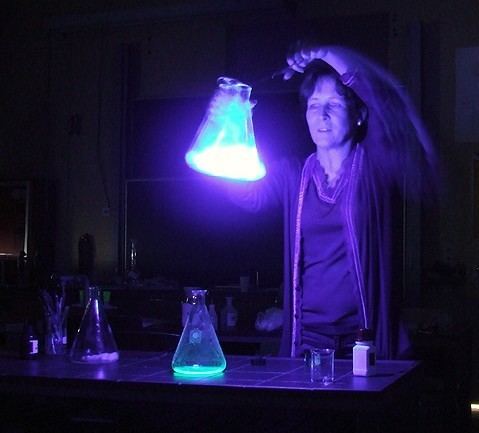 | ||
Chemiluminescence (sometimes "chemoluminescence") is the emission of light (luminescence), as the result of a chemical reaction. There may also be limited emission of heat. Given reactants A and B, with an excited intermediate ◊,
Contents
- Liquid phase reactions
- Gas phase reactions
- Infrared chemiluminescence
- Enhanced chemiluminescence
- Applications
- Biological applications
- References
For example, if [A] is luminol and [B] is hydrogen peroxide in the presence of a suitable catalyst we have:
where:
The decay of this excited state[◊] to a lower energy level causes light emission. In theory, one photon of light should be given off for each molecule of reactant. This is equivalent to Avogadro's number of photons per mole of reactant. In actual practice, non-enzymatic reactions seldom exceed 1% QC, quantum efficiency.
In a chemical reaction, reactants collide to form a transition state, the enthalpic maximum in a reaction coordinate diagram, which proceeds to the product. Normally, reactants form products of lesser chemical energy. The difference in energy between reactants and products, represented as
Chemiluminescence differs from fluorescence or phosphorescence in that the electronic excited state is the product of a chemical reaction rather than of the absorption of a photon. It is the antithesis of a photochemical reaction, in which light is used to drive an endothermic chemical reaction. Here, light is generated from a chemically exothermic reaction.
A standard example of chemiluminescence in the laboratory setting is the luminol test. Here, blood is indicated by luminescence upon contact with iron in hemoglobin. When chemiluminescence takes place in living organisms, the phenomenon is called bioluminescence. A light stick emits light by chemiluminescence.
Liquid-phase reactions
Gas-phase reactions
Infrared chemiluminescence
In chemical kinetics, infrared chemiluminiscence (IRCL) refers to the emission of infrared photons from vibrationally excited product molecules immediately after their formation. The intensities of infrared emission lines from vibrationally excited molecules are used to measure the populations of vibrational states of product molecules.
The observation of IRCL was developed as a kinetic technique by John Polanyi, who used it to study the attractive or repulsive nature of the potential energy surface for gas-phase reactions. In general the IRCL is much more intense for reactions with an attractive surface, indicating that this type of surface leads to energy deposition in vibrational excitation. In contrast reactions with a repulsive potential energy surface lead to little IRCL, indicating that the energy is primarily deposited as translational energy.
Enhanced chemiluminescence
Enhanced chemiluminescence is a common technique for a variety of detection assays in biology. A horseradish peroxidase enzyme (HRP) is tethered to an antibody that specifically recognizes the molecule of interest. This enzyme complex then catalyzes the conversion of the enhanced chemiluminescent substrate into a sensitized reagent in the vicinity of the molecule of interest, which on further oxidation by hydrogen peroxide, produces a triplet (excited) carbonyl, which emits light when it decays to the singlet carbonyl. Enhanced chemiluminescence allows detection of minute quantities of a biomolecule. Proteins can be detected down to femtomole quantities, well below the detection limit for most assay systems.
Applications
Biological applications
Chemiluminescence has been applied by forensic scientists to solve crimes. In this case, they use luminol and hydrogen peroxide. The iron from the blood acts as a catalyst and reacts with the luminol and hydrogen peroxide to produce blue light for about 30 seconds. Because only a small amount of iron is required for chemiluminescence, trace amounts of blood are sufficient.
In biomedical research, the protein that gives fireflies their glow and its co-factor, luciferin, are used to produce red light through the consumption of ATP. This reaction is used in many applications, including the effectiveness of cancer drugs that choke off a tumor's blood supply. This form of bioluminescence imaging allows scientists to test drugs in the pre-clinical stages cheaply. Another protein, aequorin, found in certain jellyfish, produces blue light in the presence of calcium. It can be used in molecular biology to assess calcium levels in cells. What these biological reactions have in common is their use of adenosine triphosphate (ATP) as an energy source. Though the structure of the molecules that produce luminescence is different for each species, they are given the generic name of luciferin. Firefly luciferin can be oxidized to produce an excited complex. Once it falls back down to a ground state a photon is released. It is very similar to the reaction with luminol.
Many organisms have evolved to produce light in a range of colors. At the molecular level, the difference in color arises from the degree of conjugation of the molecule, when an electron drops down from the excited state to the ground state. Deep sea organisms have evolved to produce light to lure and catch prey, as camouflage, or to attract others. Some bacteria even use bioluminescence to communicate. The common colors for the light emitted by these animals are blue and green because they have shorter wavelength than red and can transmit more easily in water.
Chemiluminescence is different from fluorescence. Hence the application of fluorescent proteins such as Green fluorescent protein is not a biological application of chemiluminescence.
